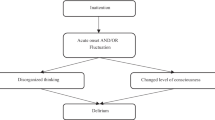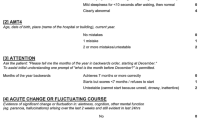Abstract
The Confusion Assessment Method for the Intensive Care Unit (CAM-ICU) is a robust and reliable instrument for discerning delirium within the specific context of the intensive care unit (ICU). Nonetheless, the CAM-ICU is burdened by various limitations, including a protracted learning curve and the need for frequent daily administration. The 4 A’s Test (4AT) was formulated to assess delirium in hospitalized patients and may have distinct advantages over the CAM-ICU, particularly regarding practical applicability within the ICU bundle. This study was performed to assess the utility of the 4AT in detecting delirium in critically ill patients. This multicenter prospective observational study involved critically ill patients at four academic tertiary care hospitals in South Korea from June 2021 to September 2022. In total, 274 patients (median age, 64 years; 56.9% men) were included, and 75 (27.4%) developed delirium. The 4AT showed good performance in detecting ICU delirium (area under the curve, 0.879; P < 0.001). The 4AT showed a sensitivity of 74.0%, specificity of 95.4%, positive predictive value of 77.5%, negative predictive value of 94.6%, and accuracy of 91.7% for ICU detection of delirium. The sensitivity, specificity, positive predictive value, negative predictive value, and accuracy of the CAM-ICU for detecting ICU delirium were 71.3%, 97.1%, 83.8%, 94.1%, and 92.6%, respectively. The 4AT showed acceptable reliability and validity for detecting ICU delirium in critically ill patients. Because the 4AT is simpler and easier to learn, this scale could be a useful alternative to the CAM-ICU for detecting delirium in critically ill patients.


Similar content being viewed by others
Data availability
The data set supporting the results of this study is available from the corresponding author upon reasonable request.
Abbreviations
- ICU:
-
Intensive care unit.
- CAM-ICU:
-
Confusion Assessment Method for the intensive care unit.
- 4AT:
-
4A’s test.
- DSM-5:
-
Diagnostic and Statistical Manual of Mental Disorders-5.
- IRB:
-
Institutional review board.
- ROC:
-
Receiver operating characteristic.
- PPV:
-
Positive predictive value.
- NPV:
-
Negative predictive value
References
Salluh JI, Soares M, Teles JM, Ceraso D, Raimondi N, Nava VS, Blasquez P, Ugarte S, Ibanez-Guzman C, Centeno JV, Laca M, Grecco G, Jimenez E, Árias-Rivera S, Duenas C, Rocha MG (2010) Delirium epidemiology in critical care (DECCA): an international study. Crit Care 14:R210. https://doi.org/10.1186/cc9333
Krewulak KD, Stelfox HT, Leigh JP, Ely EW, Fiest KM (2018) Incidence and prevalence of delirium subtypes in an adult ICU: a systematic review and meta-analysis. Crit Care Med 46:2029–2035. https://doi.org/10.1097/ccm.0000000000003402
Stollings JL, Kotfis K, Chanques G, Pun BT, Pandharipande PP, Ely EW (2021) Delirium in critical illness: clinical manifestations, outcomes, and management. Intensive Care Med 47:1089–1103. https://doi.org/10.1007/s00134-021-06503-1
van den Boogaard M, Peters SA, van der Hoeven JG, Dagnelie PC, Leffers P, Pickkers P, Schoonhoven L (2010) The impact of delirium on the prediction of in-hospital mortality in intensive care patients. Crit Care 14:R146. https://doi.org/10.1186/cc9214
Mart MF, Williams Roberson S, Salas B, Pandharipande PP, Ely EW (2021) Prevention and Management of Delirium in the Intensive Care Unit. Semin Respir Crit Care Med 42:112–126. https://doi.org/10.1055/s-0040-1710572
la Cour KN, Andersen-Ranberg NC, Weihe S, Poulsen LM, Mortensen CB, Kjer CKW, Collet MO, Estrup S, Mathiesen O (2022) Distribution of delirium motor subtypes in the intensive care unit: a systematic sco** review. Crit Care 26:53. https://doi.org/10.1186/s13054-022-03931-3
Gusmao-Flores D, Salluh JI, Chalhub R, Quarantini LC (2012) The confusion assessment method for the intensive care unit (CAM-ICU) and intensive care delirium screening checklist (ICDSC) for the diagnosis of delirium: a systematic review and meta-analysis of clinical studies. Crit Care 16:R115. https://doi.org/10.1186/cc11407
Dos Santos FCM, Rêgo AS, Montenegro WS, de Carvalho S, Cutrim RC, Júnior AAM, Pereira FHF, Dibai-Filho AV, Bassi-Dibai D (2022) Delirium in the intensive care unit: identifying difficulties in applying the Confusion Assessment Method for the Intensive Care Unit (CAM-ICU). BMC Nurs 21:323. https://doi.org/10.1186/s12912-022-01103-w
van Eijk MM, van den Boogaard M, van Marum RJ, Benner P, Eikelenboom P, Honing ML, van der Hoven B, Horn J, Izaks GJ, Kalf A, Karakus A, Klijn IA, Kuiper MA, de Leeuw FE, de Man T, van der Mast RC, Osse RJ, de Rooij SE, Spronk PE, van der Voort PH, van Gool WA, Slooter AJ (2011) Routine use of the confusion assessment method for the intensive care unit: a multicenter study. Am J Respir Crit Care Med 184:340–344. https://doi.org/10.1164/rccm.201101-0065OC
Reznik ME, Daiello LA, Thompson BB, Wendell LC, Mahta A, Potter NS, Yaghi S, Levy MM, Fehnel CR, Furie KL, Jones RN (2020) Fluctuations of consciousness after stroke: Associations with the confusion assessment method for the intensive care unit (CAM-ICU) and potential undetected delirium. J Crit Care 56:58–62. https://doi.org/10.1016/j.jcrc.2019.12.008
Steinseth EB, Høye S, Hov R (2018) Use of the CAM-ICU during daily sedation stops in mechanically ventilated patients as assessed and experienced by intensive care nurses - A mixed-methods study. Intensive Crit Care Nurs 47:23–29. https://doi.org/10.1016/j.iccn.2018.04.005
Ramoo V, Abu H, Rai V, Surat Singh SK, Baharudin AA, Danaee M, Thinagaran RRR (2018) Educational intervention on delirium assessment using confusion assessment method-ICU (CAM-ICU) in a general intensive care unit. J Clin Nurs 27:4028–4039. https://doi.org/10.1111/jocn.14525
Tieges Z, Maclullich AMJ, Anand A, Brookes C, Cassarino M, O’Connor M, Ryan D, Saller T, Arora RC, Chang Y, Agarwal K, Taffet G, Quinn T, Shenkin SD, Galvin R (2021) Diagnostic accuracy of the 4AT for delirium detection in older adults: systematic review and meta-analysis. Age Ageing 50:733–743. https://doi.org/10.1093/ageing/afaa224
Shenkin SD, Fox C, Godfrey M, Siddiqi N, Goodacre S, Young J, Anand A, Gray A, Hanley J, MacRaild A, Steven J, Black PL, Tieges Z, Boyd J, Stephen J, Weir CJ, MacLullich AMJ (2019) Delirium detection in older acute medical inpatients: a multicentre prospective comparative diagnostic test accuracy study of the 4AT and the confusion assessment method. BMC Med 17:138. https://doi.org/10.1186/s12916-019-1367-9
Hou L, Zhang Q, Cao L, Chen M, Wang Q, Li Y, Li S, Ge L, Yang K (2022) Diagnostic accuracy of the 4AT for delirium: A systematic review and meta-analysis. Asian J Psychiatr 80:103374. https://doi.org/10.1016/j.ajp.2022.103374
Heo EY, Lee BJ, Hahm BJ, Song EH, Lee HA, Yoo CG, Kim YW, Han SK, Shim YS, Lee SM (2011) Translation and validation of the Korean Confusion Assessment Method for the Intensive Care Unit. BMC Psychiatry 11:94. https://doi.org/10.1186/1471-244x-11-94
Devlin JW, Skrobik Y, Gélinas C, Needham DM, Slooter AJC, Pandharipande PP, Watson PL, Weinhouse GL, Nunnally ME, Rochwerg B, Balas MC, van den Boogaard M, Bosma KJ, Brummel NE, Chanques G, Denehy L, Drouot X, Fraser GL, Harris JE, Joffe AM, Kho ME, Kress JP, Lanphere JA, McKinley S, Neufeld KJ, Pisani MA, Payen JF, Pun BT, Puntillo KA, Riker RR, Robinson BRH, Shehabi Y, Szumita PM, Winkelman C, Centofanti JE, Price C, Nikayin S, Misak CJ, Flood PD, Kiedrowski K, Alhazzani W (2018) Clinical Practice Guidelines for the Prevention and Management of Pain, Agitation/Sedation, Delirium, Immobility, and Sleep Disruption in Adult Patients in the ICU. Crit Care Med 46:e825–e873. https://doi.org/10.1097/ccm.0000000000003299
McHugh ML (2012) Interrater reliability: the kappa statistic. Biochem Med (Zagreb) 22:276–282
Shenkin SD, Fox C, Godfrey M, Siddiqi N, Goodacre S, Young J, Anand A, Gray A, Smith J, Ryan T, Hanley J, MacRaild A, Steven J, Black PL, Boyd J, Weir CJ, MacLullich AM (2018) Protocol for validation of the 4AT, a rapid screening tool for delirium: a multicentre prospective diagnostic test accuracy study. BMJ Open 8:e015572. https://doi.org/10.1136/bmjopen-2016-015572
MacLullich AM, Shenkin SD, Goodacre S, Godfrey M, Hanley J, Stíobhairt A, Lavender E, Boyd J, Stephen J, Weir C, MacRaild A, Steven J, Black P, Diernberger K, Hall P, Tieges Z, Fox C, Anand A, Young J, Siddiqi N, Gray A (2019) The 4 ’A’s test for detecting delirium in acute medical patients: a diagnostic accuracy study. Health Technol Assess 23:1–194. https://doi.org/10.3310/hta23400
Myrstad M, Kuwelker K, Haakonsen S, Valebjørg T, Langeland N, Kittang BR, Hagberg G, Neerland BE, Bakken MS (2022) Delirium screening with 4AT in patients aged 65 years and older admitted to the Emergency Department with suspected sepsis: a prospective cohort study. Eur Geriatr Med 13:155–162. https://doi.org/10.1007/s41999-021-00558-5
Flaatten H, de Lange DW, Artigas A, Bin D, Moreno R, Christensen S, Joynt GM, Bagshaw SM, Sprung CL, Benoit D, Soares M, Guidet B (2017) The status of intensive care medicine research and a future agenda for very old patients in the ICU. Intensive Care Med 43:1319–1328. https://doi.org/10.1007/s00134-017-4718-z
Sepúlveda E, Bermúdez E, González D, Cotino P, Viñuelas E, Palma J, Ciutat M, Grau I, Vilella E, Trzepacz PT, Franco JG (2021) Validation of the Delirium Diagnostic Tool-Provisional (DDT-Pro) in a skilled nursing facility and comparison to the 4 ’A’s test (4AT). Gen Hosp Psychiatry 70:116–123. https://doi.org/10.1016/j.genhosppsych.2021.03.010
Funding
This research was supported by a grant of Patient-Centered Clinical Research Coordinating Center (PACEN) funded by the Ministry of Health & Welfare, Republic of Korea (grant number: HC20C0040).
Author information
Authors and Affiliations
Contributions
Lee YS and Sim JK had full access to all the data in the study and take responsibility for the integrity of the data as well as the accuracy of the data analysis. Lee YS and Sim JK performed study concept and design. Lee YS, Sim JK, Chung K, Chung CR, Lee J, Hwang SY performed acquisition, analysis, and interpretation of data. Lee YS and Sim JK performed drafting of the manuscript. All authors performed critical revision of the manuscript for important intellectual content. Lee YS and Hwang SY carried out statistical analysis. Lee YS obtained funding. Chung K, Chung CR, Lee J, and Hwang SY provided administrative, technical, or material support. Lee YS performed study supervision. All authors made manuscript approval. All authors read and approved the final manuscript.
Corresponding author
Ethics declarations
Conflict of interest
The authors declare that they have no conflict of interest.
Ethical approval
This study protocol was approved by the Institutional Review Boards of all the applicable institutions (IRB number: 2021GR0177). This study was carried out in strict accordance with the principles expressed in the Declaration of Helsinki, and we ensured protection of patient privacy and anonymity.
Informed consent
Written informed consent was obtained from patients or their surrogates before enrollment.
Additional information
Publisher's Note
Springer Nature remains neutral with regard to jurisdictional claims in published maps and institutional affiliations.
Supplementary Information
Below is the link to the electronic supplementary material.
Rights and permissions
Springer Nature or its licensor (e.g. a society or other partner) holds exclusive rights to this article under a publishing agreement with the author(s) or other rightsholder(s); author self-archiving of the accepted manuscript version of this article is solely governed by the terms of such publishing agreement and applicable law.
About this article
Cite this article
Sim, J.K., Chung, K., Chung, C.R. et al. Usefulness of the 4A’s test for detecting delirium in critically ill patients: a multicenter prospective observation study. Intern Emerg Med (2024). https://doi.org/10.1007/s11739-024-03670-z
Received:
Accepted:
Published:
DOI: https://doi.org/10.1007/s11739-024-03670-z




